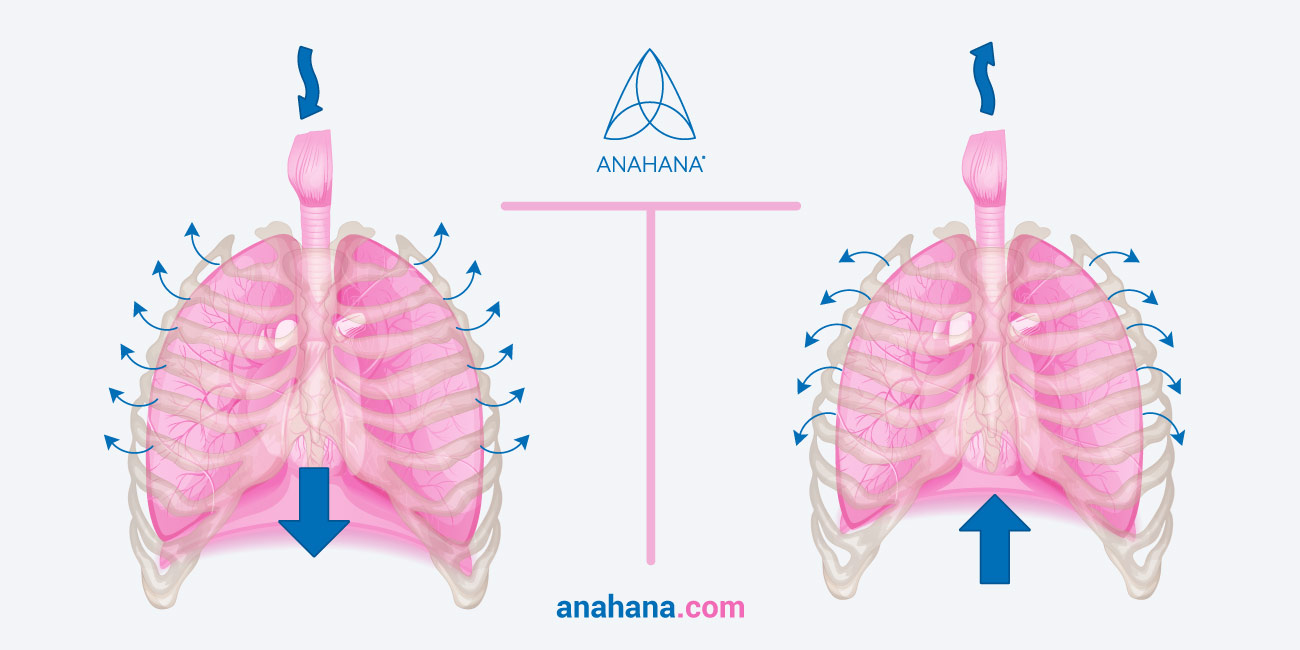
Table of Contents
Unlock a hidden gem in wellness with diaphragmatic breathing – a simple, yet transformative technique. Whether you're an athlete aiming for peak performance, battling stress, or on a quest for mindful relaxation, this method is your ally. Dive into how it enhances respiratory efficiency, melts away stress, and nurtures your overall well-being.
Diaphragmatic Breathing
Even though we are all breathing constantly, most people do not practice diaphragmatic breathing, the proper way of breathing.
This type of breathing involves taking deep, slow breaths from the bottom of the abdomen and filling up your lungs with each inhalation.
Chest breathing is the opposite of diaphragmatic or diaphragm breathing. With chest breathing, breaths are shallow, and only the top portion of the lungs fills with air upon each inhale. This type of breathing can lead to fatigue, lightheadedness, and a buildup of excess stress over time.
What is Diaphragmatic Breathing Exercise?
Diaphragmatic breathing, also known as deep belly breathing or abdominal breathing, is a breathing technique that involves engaging the diaphragm, a dome-shaped muscle located below the lungs.
To practice diaphragmatic breathing, one must inhale deeply, allowing the diaphragm to contract and move downward, creating more space for the lungs to expand fully. This will enable practitioners to breathe more oxygen-rich air, leading to a more efficient breathing pattern.
During diaphragmatic breathing, the abdomen expands as one inhales and contracts as one exhales. Normal breathing is often shallow, which puts stress on the chest and shoulders, resulting in limited air intake and increased body tension.
By making diaphragmatic breathing a regular part of one’s breathing habits, you can experience numerous benefits, including reduced stress and blood pressure, improved oxygen intake, enhanced relaxation, and better overall respiratory health.
Diaphragmatic Breathing Benefits
Numerous health benefits are associated with the diaphragmatic breathing technique. Mental and physical benefits include
- Reduced Chronic Stress
- Better Sleep
- Pain Management
- Reversed Stress Response
- Improved Mental Clarity
- Lowered Blood Pressure
- Improved Respiratory Function
- Balanced autonomic nervous system
- Improved Core Muscle Stability
- Enhanced Endurance
- Strengthened Immune System
Many breathing-related conditions can be improved with belly breathing. This includes COPD, asthma, and even dyspnea (when you have shortness of breath and/or can’t take a deep breath without yawning).
Risks and Contraindications
While diaphragmatic breathing exercises are generally safe and beneficial for most people, there are certain risks and contraindications to be aware of such as hyperventilation, respiratory conditions, cardiovascular conditions, head and neck injuries.
As with any new exercise or wellness practice, listening to the body and proceeding with awareness and caution is essential.
If practitioners have any pre-existing medical conditions or concerns about their health, it's advisable to consult a healthcare professional before starting diaphragmatic breathing or any other new breathing technique.
They can provide personalized guidance and ensure the practice is safe and suitable for you.
How to Perform the Diaphragm Exercise
Performing diaphragmatic breathing is a simple and effective exercise that one can perform anywhere, anytime. Follow these steps to practice the diaphragm exercise:
- Find a Comfortable Position: Sit or lie down in a comfortable position. You can sit in a chair with your feet flat on the ground and your hands resting on your abdomen or lie on a flat surface with a pillow supporting your head and knees bent.
- Relax Your Body: Close your eyes and take a few deep breaths to relax your body and mind. Consciously let go of any tension, keeping your shoulders, head, and neck relaxed.
- Place Your Hands: Place one hand on your chest and the other on your abdomen below your ribcage. This will help you become aware of the movement as you breathe.
- Inhale Slowly: Breathe in slowly through your nose. As you inhale, focus on seeing the oxygen down to your lower belly, feeling your abdomen rise as your chest remains still.
- Exhale Gradually: Slowly and gently exhale through pursed lips. Feel your abdomen fall as you release your breath. Aim for a longer exhale than the inhale.
- Stay Mindful: Pay attention to the sensation of your breath as it moves in and out of your body. Focus on the rise and fall of your abdomen, and try to keep your breathing smooth and even.
Remember, diaphragmatic breathing might initially feel unfamiliar, especially if you are used to shallow breathing. Be patient with yourself and practice regularly to make it a natural part of your breathing pattern.
Over time, diaphragmatic breathing will become easier, and you will begin to experience its numerous benefits.
Creating a Deep Breathing Routine

Creating a deep breathing routine involves several steps to incorporate this beneficial practice into your daily life. Follow these steps to establish a deep breathing routine:
Set Your Intentions
Determine why you want to incorporate deep breathing into your routine.
Whether it's to reduce stress, improve focus, or promote relaxation, clarifying your intentions will help you stay motivated and committed to the practice.
Choose a Time
Select a specific time of day that works best for you to practice deep breathing. It could be in the morning to start your day calmly, during a lunch break to re-energize, or in the evening to unwind and prepare for sleep.
Create a Serene Space
Find a dedicated and peaceful spot to sit or lie comfortably without distractions.
Decide on Duration
Start with a manageable duration for your deep breathing sessions, such as 5 to 10 minutes. Gradually increase the duration as you become more comfortable with the practice.
Be Consistent
Commit to practicing deep breathing regularly. Consistency is essential for experiencing the full benefits of this routine. Consider setting a reminder or incorporating it into your daily schedule.
Use It Throughout the Day
Deep breathing doesn't have to be limited to your dedicated sessions. Whenever you encounter stress or need a moment of calm, take a few deep breaths to center yourself.
By following these steps and making deep breathing a consistent part of your daily routine, you can enjoy its numerous physical and mental benefits, leading to improved overall well-being and a greater sense of calm and balance in your life.
Frequently Asked Questions
Is diaphragmatic breathing good for people with chronic obstructive pulmonary disease (COPD)?
Yes, diaphragmatic breathing can benefit people with chronic obstructive pulmonary disease (COPD). In fact, it is often recommended as a helpful technique for managing COPD symptoms and improving respiratory function.
COPD is a chronic lung disease that makes breathing difficult for individuals, causing shortness of breath. Diaphragmatic breathing can be advantageous for people with COPD because it encourages deep, slow breaths that engage the diaphragm and maximizes lung expansion.
By practicing diaphragmatic breathing, individuals with COPD can:
- Increase Lung Capacity
- Enhance Respiratory Muscle Strength
- Reduce Shortness of Breath
- Promote Relaxation
- Improve Oxygenation
- Assist With Mucus Clearance
Still, individuals with COPD must consult their healthcare provider or a respiratory therapist before starting any deep breathing exercises, including diaphragmatic breathing.
They can provide personalized guidance, ensure that the technique suits individual needs and limitations, and address any specific concerns related to the person's COPD condition.
Is diaphragmatic breathing good for athletes?
Yes, diaphragmatic breathing is highly beneficial for athletes as it improves the body’s ability to tolerate intense exercise.
What is the difference between diaphragmatic and belly breathing?
Essentially, belly breathing and diaphragmatic breathing are the same thing. Both types of breathing involve taking slow deep breaths and engaging the diaphragm. By doing this, the abdomen will expand outward as you inhale and retract back toward the spine as you exhale.
Is belly breathing bad or good?
Belly breathing is very good for you. Taking deep breaths from the lower abdomen and fully inflating the lungs encourages the complete exchange of oxygen. It can also reduce stress and lower anxiety.
Is it better to breathe through the upper chest or using the abdominal muscles?
It is called belly breathing because you use the diaphragm, a breathing exercise where your abdominal muscles are used rather than your rib cage. Learning diaphragmatic breathing is not hard, and anyone can do it.
Using your diaphragm gives you as much oxygen as possible into your system. You simply need to find the breathing techniques that work for you, and belly breathing would be one of these.
References
Stress Management: Breathing Exercises for Relaxation
Relaxation techniques: Breath control helps quell errant stress response - Harvard Medical School
Learning diaphragmatic breathing - Harvard Health.
Breathing retraining and diaphragmatic breathing techniques
Disclaimer
The contents of this article are provided for informational purposes only and are not intended to substitute for professional medical advice, diagnosis, or treatment. It is always recommended to consult with a qualified healthcare provider before making any health-related changes or if you have any questions or concerns about your health. Anahana is not liable for any errors, omissions, or consequences that may occur from using the information provided.

By: Clint Johnson
Clint is the driving force and founder of Anahana. Clint teaches Yoga, Pilates, mindful breathing, and meditation, catering to a global community of students and teachers.